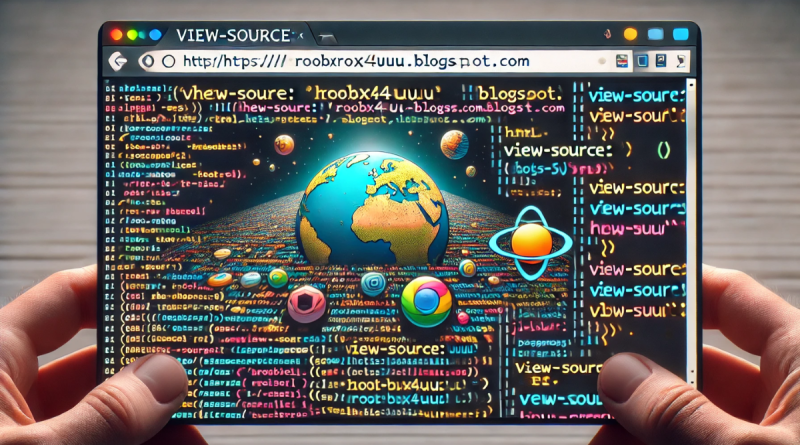Understanding and Using views-source:https://roobx4uuu.blogspot.com for Web Code Insights
Introduction
The “views-source” command is a powerful tool for viewing a webpage’s underlying HTML, CSS, and JavaScript, enabling users to inspect how specific web components work. For developers and enthusiasts, “views-source:https://roobx4uuu.blogspot.com” allows instant access to the underlying code structure of the site roobx4uuu.blogspot.com. By exploring this source, users can gain insights into code structures, layout patterns, and interactive elements that make up the page’s design and functionality.
1. What is the “views-source” Command?
The “views-source” command is a web inspection tool available in most browsers that enables users to view the source code of a webpage. This command serves as a way to explore the technical details behind a site’s visual elements and functionality. Using “views-source” allows you to view the code of any web page by typing view-source: before the URL. This method is particularly useful for those who want to learn how websites are structured.
Why it Matters: For beginners and experts alike, “views-source” helps visualize how developers build website structures and integrate design elements into their pages.
Key Points
- HTML Insights: Understand how webpages are structured.
- CSS Analysis: See how styles are applied.
- JavaScript Inspection: Observe interactive functions.
2. How to Access “views-source:https://roobx4uuu.blogspot.com“
Viewing the source code for a specific website URL, like “views-source:https://roobx4uuu.blogspot.com,” is straightforward:
- Open a Browser: Google Chrome, Mozilla Firefox, and Safari all support the “views-source” command.
- Type the URL: In the address bar, enter
view-source:followed by the website URL.- Example:
view-source:https://roobx4uuu.blogspot.com
- Example:
- Press Enter: This command will take you to the source code of the blog page.
3. Benefits of Using “views-source” for Beginners
The “views-source” command can provide various benefits, especially for those looking to improve their coding knowledge.
Why Beginners Should Use “views-source”
- Learn Basic HTML Structure: HTML tags are the foundation of web pages, and viewing source code reveals each element’s role.
- See CSS in Action: The source code includes linked or embedded CSS, showing how visual styles and layouts are created.
- Understand JavaScript Functions: JavaScript in the source code reveals how interactive features are integrated, from buttons to animations.
Tips for Learning Through “views-source”
- Identify Key HTML Elements: Look for
<div>,<header>, and<footer>tags. - Explore Embedded Styles: Examine the styles applied with
<style>tags or linked through CSS files. - Study JavaScript Functions: Look for interactive JavaScript functions, often identified by
<script>tags.
4. Exploring the Code on roobx4uuu.blogspot.com
By typing “views-source:https://roobx4uuu.blogspot.com,” you will see all the HTML, CSS, and JavaScript that powers this blog. Let’s break down what you might encounter.
Key Elements to Notice
- Header Elements: Most blogs include a header section defining the title and metadata.
- Main Content Area: This section contains the actual blog posts, structured with HTML tags.
- CSS Classes and IDs: Specific styles are usually linked through classes and IDs, making the content visually engaging.
- Scripts for Interactivity: JavaScript functions are often placed near the end of the HTML document or linked externally.
By understanding these elements, you’ll get a clearer picture of how the blog is organized and styled.
5. Analyzing HTML, CSS, and JavaScript Components
Understanding the three major components—HTML, CSS, and JavaScript—will enhance your website knowledge, allowing you to make informed adjustments and improvements to your site.
HTML Structure
HTML is the backbone of every webpage, providing the structural elements that organize content.
- Tags to Look For:
<div>,<h1>,<p>, and<img> - Metadata:
<meta>tags at the top influence SEO and user experience. - Links: The
<a>tag allows navigation and redirection to other sites.
CSS Styling
CSS defines the visual presentation of HTML elements, including layout, color, and typography.
- Internal vs. External CSS: CSS can either be embedded within
<style>tags or linked through an external file. - Classes and IDs: Commonly found in class selectors (e.g.,
.header) and IDs (#main-content) for consistent styling. - Responsive Design: Look for media queries in CSS (
@media) for mobile compatibility.
JavaScript for Functionality
JavaScript adds interactivity, turning static elements into engaging user experiences.
- Scripts: Typically enclosed in
<script>tags, where functions are defined. - Libraries: JavaScript libraries (like jQuery) can enhance the functionality of a page.
- Common Uses: JavaScript is used to create pop-ups, sliders, and form validations.
6. Troubleshooting Common Viewing Issues
Viewing source code is typically straightforward, but some common issues can arise:
- “Access Denied” Message: This can happen if the website restricts viewing its source code.
- Minified Code: Some websites compress code, making it difficult to read.
- Cross-Browser Differences: Browsers may interpret code differently, so use a standard browser like Chrome or Firefox for accurate viewing.
Solutions:
- Use Developer Tools: Tools like Chrome DevTools offer a more organized view of minified code.
- Format the Code: Online tools can help beautify minified code.
7. FAQs
Q: What is “views-source:https://roobx4uuu.blogspot.com” used for?
A: It allows users to view and inspect the underlying HTML, CSS, and JavaScript of the blog for learning and troubleshooting.
Q: Can I copy the code from “views-source:https://roobx4uuu.blogspot.com”?
A: Technically, yes, but copying code without permission for use on another site may violate copyright policies.
Q: Why does “views-source” show compressed or “minified” code?
A: Some websites use minification to reduce file sizes and improve loading times, which can make code harder to read.
Q: Is it safe to use “views-source” for any website?
A: Yes, it’s safe and doesn’t alter the website, as it only displays code on the viewer’s side.
8. Conclusion
Understanding “views-source:https://roobx4uuu.blogspot.com” provides an accessible gateway into the world of web development. By viewing and analyzing source code, you gain insight into HTML structuring, CSS styling, and JavaScript functionalities, deepening your understanding of how websites work. Whether you’re a beginner or experienced coder, using the “views-source” command can enhance your skills and improve your ability to troubleshoot and learn from live web pages.
